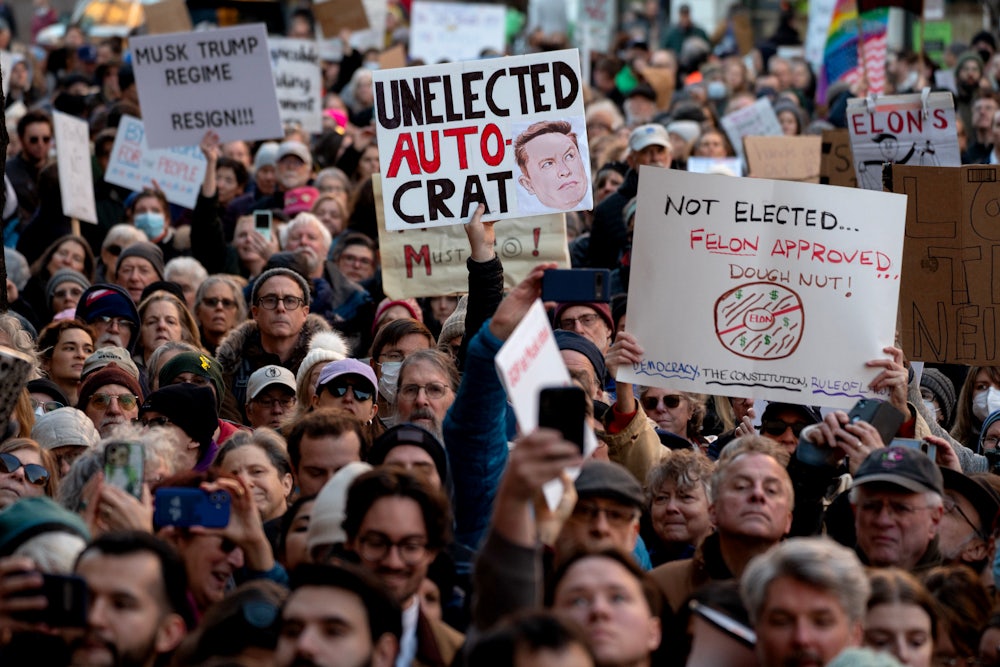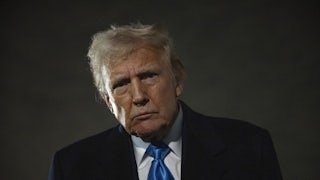Late Sunday, a reported 20,000 people joined an organizing call quickly convened by Indivisible, a group founded to push back on Trump’s first administration, in response to actions largely undertaken by one of his unelected lackeys, the chaotic tech entrepreneur Elon Musk. As the call maxed out its capacity, tens of thousands more watched via YouTube. Meanwhile, outside an otherwise unexciting federal building in Washington, federal workers and D.C. residents assembled. Inside, under orders from Musk (who apparently paid his way into the president’s good graces), a small group of young men, whose only professional experience was working for one of Musk’s or Musk’s cronies’ companies, were wreaking havoc on federal payment systems. “Musk is inside the Treasury right now with his cadre of flying monkeys, and we don’t know what they’re doing,” said Indivisible co-founder Ezra Levin on the organizing call. No one seemed to know how to stop them.
But the accounts from that small protest outside the federal building, with just a few people blocking the doors—backed up by chants of “There’s a robbery in progress”—put a spotlight on the scene and gave it a story. On Monday morning, as federal workers reported lockouts from their offices, more people joined. Some protesters took to the street outside the Office of Management and Budget and blocked traffic. And the next day, Indivisible demonstrators and Democratic members of Congress gathered at the Treasury Building in opposition to Musk’s ongoing takeover, which some lawmakers were by then plainly calling an “illegal raid,” in which he “illegally seized power.” When they tried to get into Treasury on Tuesday, they were turned away. “We’re not going to allow them to steal from our people, from working-class people!” Representative Maxwell Frost said at the rally assembled outside.
In the wake of the November election, multiple news outlets ran stories suggesting that, this time, the president’s opposition were exhausted and inclined to sit this one out. But the fact that the National Mall isn’t packed with pussy-hat-wearing women does not mean that everyone has moved on. Some may have, of course, like the group of Pennsylvania women profiled in The New York Times ahead of the 2025 inauguration, whose first experience organizing was protesting Trump’s first term. (But, to be fair, we don’t know how many people in that particular demographic have really tuned out.) The story those particular protests were telling—a man who sexually assaulted women was in the White House, and himself was a threat to democracy—has only gotten more grim, more all-encompassing, in the last eight years. If anything, there is too much to protest and there are too many villains, an overwhelming number of stories competing for attention and action. But protests are, in fact, happening—and this week, more people are starting to show up.
At the same time as some lesser-known federal office buildings became sites of protest on Sunday, thousands of people across the country were turning out in opposition to Trump’s promised mass deportations and the already-escalating ICE raids: In Los Angeles (blocking the 101 Freeway), Phoenix, Las Vegas (over several days, including hundreds outside Trump’s hotel), Dallas, and Atlanta, among others. On Sunday and Monday, a few thousand people in Washington, D.C. and New York protested Trump’s attempted bans on gender-affirming care for young trans people. On Tuesday, as Trump contemplated shutting down the Department of Education by executive order, students walked out of schools in Los Angeles, and members of the Chicago Teachers Union held “walk-ins” at 100 schools, calling for protections for immigrant students, parents, and educators.
What do we know about these protests? It’s too early to make any data-based generalizations. But based on the rapid-fire research I did for this story, including going to some of these protests (both now and in the first Trump administration), they are not primarily organized under a banner of “Resist Trump.” Protests have mobilized around Trump’s orders, but they are also targeting those who are carrying out his orders, whether that’s responding to an ICE raid in their own neighborhood or to a hospital that is preemptively banning gender-affirming care. Many of these same protesters, not coincidentally, remained active no matter who was in the White House.
Their communities did not see the Biden years as a victory but as a possible reprieve. That reprieve didn’t materialize: Biden didn’t brand his deportations as Trump did, and they weren’t media spectacles, but by the numbers available, he removed as many people from the United States as Trump did in his first term. For trans people, who Biden did at least mention in some speeches and whose rights he backed in a number of executive orders, almost all of that has been undone by two weeks of Trump. The Biden years also saw a constant onslaught of attacks on trans people at the state and local level. There was nothing to sit out.
Maybe, to those who deemed protesters “tired,” this resistance doesn’t look like what they expected. Perhaps they don’t see protests led by immigrants and trans people as part of the resistance, or see these as side issues—even though those are the communities Trump is specifically targeting.
So rather than ask why people aren’t protesting now like they did (or how people imagine they did) in 2017, a better question might be, what did some people keep protesting? And which people are now joining those people—even though the dominant narrative in the media continues to be that the opposition to Trump is limited and the first-term #resistance ultimately didn’t accomplish much?
A few nights ago, in a park within shouting distance of NYU-Langone, thousands turned out to demand the hospital restore gender-affirming care for young trans people. But the demonstration’s primary target was not Trump: It was Robert Grossman, the CEO of the hospital. Organizers got people chanting (and remembering) his name. Signs in the crowd listed his NYU email address and phone number (and a reminder to please be polite to the receptionists). Nearly everyone who spoke—trans kids who are in high school or just starting college and whose care was in jeopardy; union members at NYU and at the hospital pushing back on management decisions to end care; Cynthia Nixon, whose trans son was a patient at that hospital—aimed their demands at the hospital leadership, who did not have to obey Trump’s unlawful order but chose to.
The people who seem to have been first in the streets, this time, are among those who did not go anywhere after 2020 just because Trump did. The people now activated by Musk are joining them. What broke through and gave them something to fight was something unprecedented: Musk’s deeply bizarre takeover—moving sofa beds and sketchy servers into federal offices and kicking staff out; appointing young randos to carry out his dirty work; hanging out on X and pledging to shut down payments based on screenshots of federal financial records posted by QAnon supporters. Despite the significant number of people who already knew Musk was a dangerous crank, this offered a new fight on new turf. We are not living in a rerun; the “resistance” will not be one, either.








